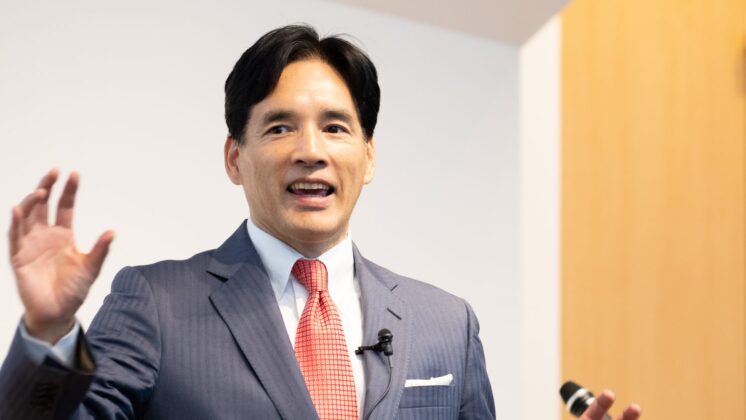Harvard Business School (HBS) reunions are held every five years, over three nights and four days from the end of May to the beginning of June. This year marks my ten-year reunion.
Time flies.
The first day is registration and a reception. The second includes lectures by professors and an evening get-together with section mates. The third day is more lectures, a panel discussion, and an award presentation and speech by the Dean. There is also a black-tie party in the evening. Finally, the four day sees us all off with a brunch and a farewell.
I had three main interests in this reunion.
· The changes in people over the past decade
· The faculty presentations
· What I could learn from the HBS Alumni Service to make GLOBIS Management School the No.1 management graduate school in Japan
I arrived in Boston via Chicago on Thursday, only to find upon my arrival in Boston that my luggage had gotten lost somewhere along the way. Unbelievable. I knew the operations of U.S. airports were poor, but I was nonplussed at how bad customer support was.
With the luggage ordeal and lots of emails to send to Japan, I had to miss the reception in the hotel that evening.
The next morning, I got on the bus and headed for HBS. There are four faculty presentation sessions per day (two in the morning and two in the afternoon). In each session, more than 10 professors present current research in their respective fields. We alumni were able to freely select the presentations we attend from more than forty offered. It was a lot of fun.
The presentations were generally characterized by topics on the internet, venture capital, and venture-related issues. This was a very valuable opportunity, and I chose lectures focused on subjects that I would not usually hear about.
For the first lecture, I decided on “When Good Management Can Hurt Your Company,” by Professor Clayton Christensen, who is currently renowned for his work on disruptive technology. Basically, his research revealed that whenever some companies go beyond the expectations of the mass market to target high-end customers and continue to evolve their products into higher-quality, higher-priced goods, new entrants will appear with innovative, disruptive approaches and technologies. Those new entrants win the hearts of the customer with products that have same quality but cost less and are easier to use, eventually overturning existing corporations. Professor Christensen cited as examples the way that PCs replaced main-frame computers and electric furnaces replaced blast furnaces, as well as the emerging dominance of transistors pioneered by Sony over vacuum tubes and department stores over supermarkets.
The final example was the challenge to established business schools by new entrants. When I was at HBS in March, everyone told me that the greatest threat for HBS in the future would most likely come from schools like GLOBIS Management School that acquire customers through new methods and provide practical coursework. This lecture was rich in ideas.
For the second lecture, I chose professor David Garvin’s “Putting the Learning Organization to Work.” Professor Garvin is well known in the area of learning organizations, and as the owner of GLOBIS Organizational Learning, a management development company for corporate clients, this was something I really wanted to hear about. Products and services can be copied. And even management and technology are easy to obtain externally. The only real source for establishing competitive advantage is the speed with which your organization can learn. I won’t go into all the details, but one of the goals for GLOBIS this year is to have every staff member become a CLO, or Chief Learning Officer, and I am thinking of having study sessions on this within the company.
The third lecture I selected was by professor Robert Simons, who talked about “How High Is Your Return on Management (ROM).” This is in the same accounting domain as professor Kaplan, but emphasizes ROM rather than return on equity (ROE).
“The principle resource constraint that companies face these days is not in capital, technology, or R&D, but in management resources in the sense of time and energy. The issue is how far you can maximize these management resources.” This was written in the pamphlet and it instantly made a lot of sense to me, so I dismissed other popular classes and decided to attend this one.
For the fourth lecture, I attended both “Opportunities and Challenges Facing Professional Service Firm Leaders” and “Software Development in the Internet Age.”
I listened attentively all day to cutting-edge research, and on the bus on the way back I got information from a classmate about other lectures. I did the same things five years ago at the last reunion, and I was relieved to fill in the gaps as I headed back to the hotel.
HBS has a class system known as “sections,” in which each of the nine sections has 90 people, meaning that one academic year is composed of some 800 students (somehow only our section had 80 instead of 90). Any given section takes all the same classes together for the entire year, sitting in the same place. Required subjects in the second year are also taken together. At HBS, you continually study and debate with the same section mates in this challenging atmosphere.
Many of my section mates married their college sweethearts, so it has really become a family affair. At the goodwill of a section mate named Dan, a party was held at his amazing house. Dan had been at Summit Partners and CMGI before creating his own venture capital. He moved to his palatial home last year, fully enjoying the expansive conditions of the late ’90s.
Everyone came to the party in Hawaiian attire with their spouses in tow. On arrival, each person was greeted with a tropical drink and a lei. There was a reggae band and a covered area in the garden where dinner was served.
It was like traveling back in time. No one had really changed that much in ten years, except that now they definitely owned more property and social status. Each of us had about three children, and everyone’s deepest concern tended to be lifestyle. They would talk about things like having to get bigger homes as they had more kids or wanting to cut back on business trips or changing workplaces to allow more time with family.
Occupation-wise, most had started out ten years ago in consulting and investment banking, but now about half of my section mates were involved in private equity investment such as venture capital and buyouts. The second most frequent occupation in which people were engaged seemed to be individually owned companies, such as consulting firms. There was also a surprisingly large number of people who were long-termers in major business enterprises such as GM and Enron.
Three or four section mates had started venture firms but now, having sold their companies, they were now working in consulting or private equity. They probably won’t try venture firms again, which no doubt is something you do best when you are young with lots of energy.
I was often asked if I was still at GLOBIS. Americans tend to quickly sell off companies and appear to be predisposed to think in these terms. Whenever I am asked this, I say, “I’ll stay with GLOBIS for as long as I live.” I can’t imagine selling (quitting) something that is so much fun. What’s more, we’ve just gotten started.
The measure of success in the U.S. seems to be centered on money, with work and careers as the means for acquiring enough to live the lifestyle you want. It will be interesting to see how people change in another five years.



